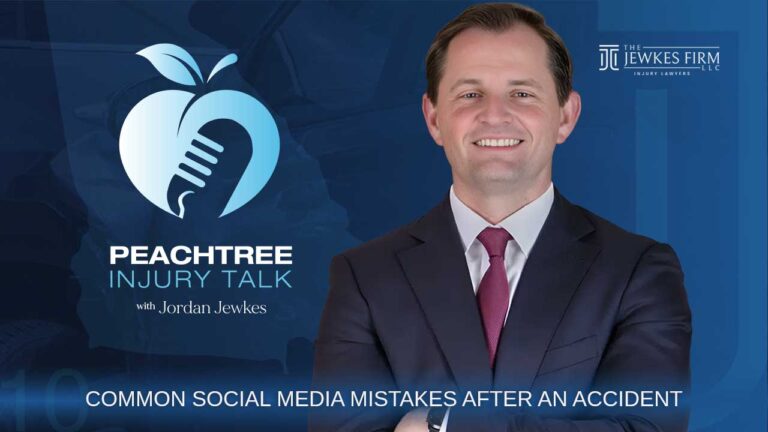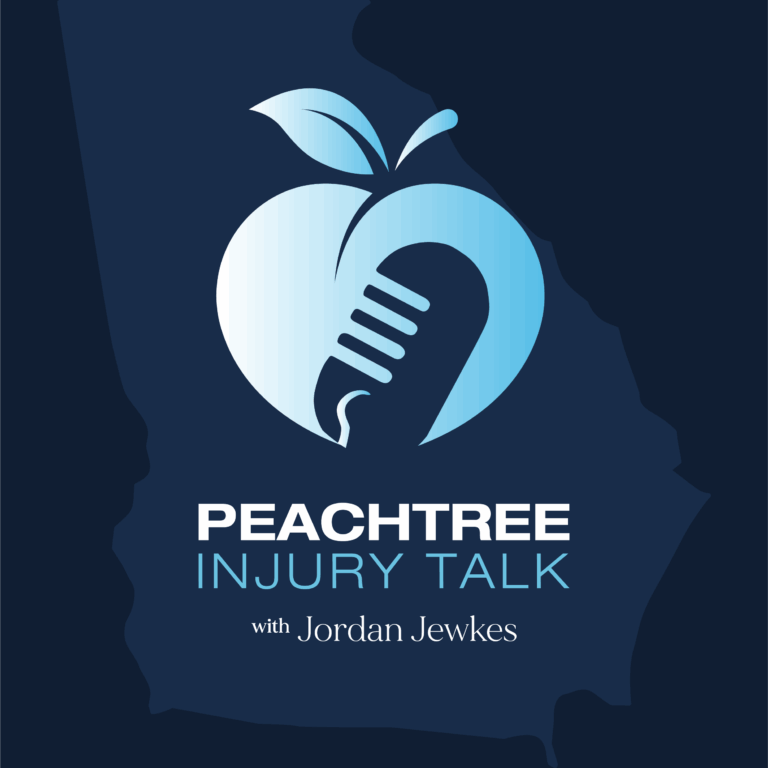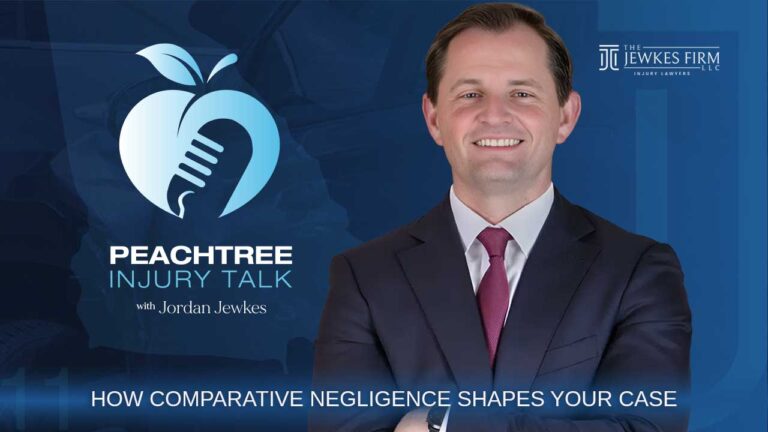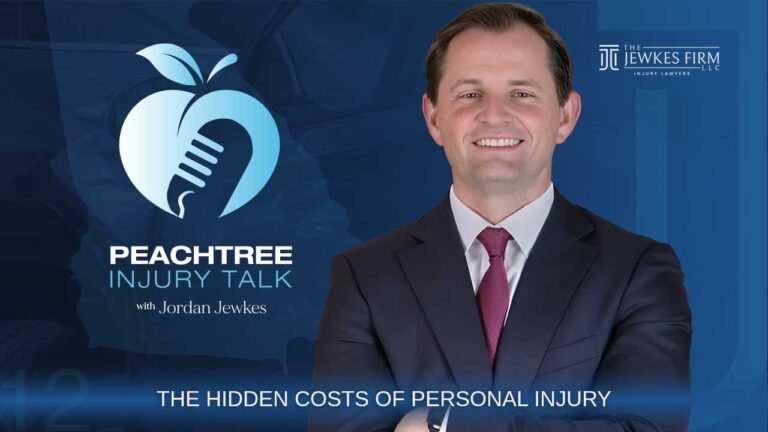
The Hidden Dangers — Common Social Media Mistakes After an Auto Accident
In this episode, Jordan Jewkes dives into the risks and mistakes associated with social media use after an auto accident. Jordan explains how social media
Home | Podcasts | Peachtree Injury Talk | Understanding Comparative Negligence in Georgia
Peachtree Injury Talk with Jordan Jewkes
In this episode of Peachtree Injury Talk, attorney Jordan Jewkes explains Georgia’s modified comparative negligence law, which affects how fault is determined in personal injury cases. If you’re 49% or less at fault, you can still recover damages—reduced by your fault percentage. But if you’re 50% or more at fault, you get nothing. Jewkes discusses how insurance companies manipulate fault assessments to avoid payouts, the importance of early evidence, and why experienced legal representation is crucial in shared-fault cases. He also breaks down complex scenarios like multi-vehicle and commercial accidents.
| 00:00 | Narrator: Welcome to Peachtree Injury Talk with attorney Jordan Jewkes. |
| 00:05 | Kevin Rosenquist: Hello and welcome to Peachtree Injury Talk with attorney Jordan Jewkes. Jordan strives to give injured victims a voice and provides strong advocacy against an often broken system. I’m your host, Kevin Rosenquist, and today’s episode is What If It’s Partly Your Fault? Understanding Comparative Negligence in Georgia. Jordan, welcome back. |
| 00:26 | Jordan Jewkes: Hey, Kevin, good to see you. Thanks for having me. |
| 00:28 | Kevin Rosenquist: Yeah, good to see you too. Let’s dive right in. What exactly is comparative negligence, and how does it apply to personal injury cases in Georgia? |
| 00:37 | Jordan Jewkes: Great question. I know it might sound boring on the surface, but it’s actually a really important and interesting area of the law. Georgia follows what’s called a modified comparative negligence statute. Think of it like a blame pie. If there's a car wreck, who gets what slice of blame? In Georgia, if you're found to be more than 50% at fault for the accident, you can't recover anything. But if you're 49% or less at fault, you can recover damages—just reduced by your percentage of fault. So, for example, if you're found to be 25% at fault, you can recover 75% of your damages. But once you hit 50% or more, you’re out of luck. |
| 01:44 | Kevin Rosenquist: So have you ever had a client right at that 49% mark? |
| 01:52 | Jordan Jewkes: That’s the golden zone we aim for when our client has some fault. It’s definitely splitting hairs, but yes, we’ll argue to the jury: “We admit there's some fault, but not more than 49%.” Because if a jury finds you even 51% at fault, you're barred from recovery—no matter how serious the injury. |
| 02:17 | Kevin Rosenquist: You mentioned a jury. Does comparative negligence only come into play if the case goes to trial? |
| 02:29 | Jordan Jewkes: No, that “blame pie” analysis starts from day one. If a potential client tells me they were backing out of a parking space and someone hit them, I immediately start thinking about percentages. If I believe the insurance company is likely to argue that my client is 50% or more at fault, that’s a really tough decision on whether to take the case. So yes, the analysis is done long before trial. But the jury is the only one who can make a binding determination of fault. |
| 03:27 | Kevin Rosenquist: Got it. So in a case where both parties share fault but don’t go to trial, how is that percentage determined? |
| 03:36 | Jordan Jewkes: Ideally, it’s determined through negotiation. A good attorney—and a good insurance adjuster, honestly—tries to predict what a jury might do. If it seems like a jury would assign your client more than 50% of the blame, you’ve got to be honest about that and potentially decline the case. |
| 04:34 | Kevin Rosenquist: Do insurance companies try to exploit comparative negligence to lower their payouts? |
| 04:43 | Jordan Jewkes: Oh, absolutely. That’s putting it lightly. Insurance companies routinely try to inflate the percentage of fault on our clients to avoid paying full damages. We had a case where our client stopped suddenly to avoid a collision. The driver behind them didn’t stop in time and rear-ended them. That driver’s insurance company tried to claim it was our client’s fault for stopping too suddenly—even though they managed to avoid hitting the car in front of them, while the other driver didn’t. That’s just one example of how insurance companies misuse the rule. |
| 05:27 | Kevin Rosenquist: So what kind of evidence becomes important in those cases? |
| 05:38 | Jordan Jewkes: The approach doesn’t necessarily change—we always gather as much evidence as possible—but the emphasis might shift. In a potential comparative negligence case, we’ll really focus on police reports, dash cam footage, body cam footage, and witness statements. We communicate with the insurance companies early and control the narrative. If we know an apology was made at the scene, we’ll prepare to explain it with the context—and ideally back it up with video that supports our client’s version. |
| 07:29 | Kevin Rosenquist: Is that why you advise clients not to admit fault at the scene? |
| 07:35 | Jordan Jewkes: Exactly. People want to be polite—they say, “I’m so sorry,” even when they didn’t do anything wrong. But insurance companies will absolutely use that against you. We tell clients: don’t apologize and don’t admit fault. Let the police handle it. |
| 08:24 | Kevin Rosenquist: Do you like the comparative negligence law as it stands? |
| 08:27 | Jordan Jewkes: Like many laws, it has good intentions. But insurance companies abuse it. Some states follow pure comparative negligence laws. In those states, you can still recover even if you're 75% at fault—you just recover 25% of your damages. Georgia’s system is harsher: if you're just over 50%, you're completely barred. So, is the law fair? Sure. Do insurance companies play fair with it? Not always. |
| 09:28 | Kevin Rosenquist: Is it difficult to determine fault percentages? There’s no formula, right? |
| 09:34 | Jordan Jewkes: Right—there’s no app or algorithm for it. It comes down to experience and the specific facts of the case. Some cases are easy. If you rear-end someone, odds are you're mostly at fault. But in other cases—like a T-bone at an intersection or two cars turning—it depends on witnesses, video footage, and other evidence. I had a recent case where someone was backing out of a parking space and got hit. Luckily, there was camera footage. We talked through it, and honestly, it was a tough case for them. |
| 10:45 | Kevin Rosenquist: Yeah, I can picture that. If you're the one backing out, it's hard not to have at least some fault unless the other driver is doing something really unusual. |
| 10:52 | Jordan Jewkes: Exactly. Fortunately, there wasn’t a major injury in that case. They just needed to know whose insurance would cover the car damage. But yeah, it was a close call. |
| 11:40 | Kevin Rosenquist: What about commercial vehicles or rideshare companies? Are those harder cases? |
| 11:42 | Jordan Jewkes: They can be. Bigger companies usually fight harder. But they also have more data—especially trucking companies. Many have inward- and outward-facing cameras, GPS data, braking data, speed data, and more. If you get to that info early, it can be a goldmine. Same goes for rideshare apps—once the app is engaged, it starts collecting lots of useful data. |
| 12:59 | Kevin Rosenquist: And what happens in multi-car accidents—three, four, five cars involved? |
| 13:07 | Jordan Jewkes: The more vehicles, the harder it gets. Think of that same blame pie—now you’ve got to cut it into even more slices. If there’s a chain-reaction crash, or someone swerves to avoid something and hits others, it becomes very complex. Sometimes we sue multiple drivers, even when our client has zero fault, because the insurance companies for the other parties can’t agree on who’s to blame. |
| 13:56 | Kevin Rosenquist: That’s wild. Can the insurance companies resolve that themselves? |
| 14:07 | Jordan Jewkes: Sometimes, yes. They’ll enter into something called arbitration, where a neutral third party hears their arguments and makes a decision about fault. We’re not involved in that directly, and it’s not binding on us, but it can help clarify things. If they can’t agree or one side won’t accept the arbitrator’s ruling, then we file a lawsuit and let the jury decide. |
| 16:37 | Kevin Rosenquist: That makes sense. Seems like a lot of moving parts, especially when your client didn’t do anything wrong. |
| 16:39 | Jordan Jewkes: Exactly. And that’s where we come in. Insurance companies try to take advantage of people who don’t know the law. That’s why we’re here—to level the playing field. |
| 16:41 | Kevin Rosenquist: Well, Jordan, thanks again for joining us today on Peachtree Injury Talk. To connect with Jordan and his team, visit jewkesfirm.com (https://www.jewkesfirm.com). And please like and subscribe to our channel. We’ve got lots more great content coming your way. |
| 16:59 | Jordan Jewkes: Thank you, Kevin. Always a pleasure. |
| 17:07 | Kevin Rosenquist: Thanks for watching. Be sure to hit that like and subscribe button and leave us a review in the comments. |
What If It’s Partly Your Fault? Understanding Comparative Negligence in Georgia discusses the implications of comparative negligence in personal injury cases. The episode sheds light on Georgia’s modified comparative negligence law, which impacts how courts award damages in accidents where both parties share fault.
Jordan explains that Georgia uses a “modified comparative negligence” rule, often visualized as a “blame pie.” If a person is found to be 50% or more at fault in an accident, they cannot recover any damages. However, if their fault is 49% or less, they receive compensation, which the court reduces by the percentage of fault they bear. For instance, if someone is 25% at fault, they could recover 75% of their damages. The law’s strict nature means that even being slightly more than 50% at fault results in no recovery, which is a critical consideration in personal injury cases.
The conversation touches on how this rule applies from the outset of a case, not just at trial. When clients approach Jordan, he immediately evaluates the percentage of fault they might carry. If there’s a possibility that a court could deem a client 50% or more at fault, Jordan may decide not to take the case. While juries ultimately decide fault, insurance companies also play a significant role in determining fault percentages through negotiation and settlement.
Insurance companies, Jordan notes, often exploit comparative negligence to minimize payouts. They may try to shift blame to the injured party, even in cases where the other driver is clearly at fault. For example, Jordan recounts a case where an insurance company claimed that a client was at fault for stopping suddenly to avoid a collision, despite the other driver rear-ending them.
Evidence plays a crucial role in these cases, especially in comparative negligence disputes. Jordan emphasizes the importance of gathering police reports, dash cam footage, body cam footage, and witness statements to support the client’s version of events. He also advises clients to avoid admitting fault at the scene, as insurance companies can use such statements against them later.
Kevin asks if the comparative negligence law is fair, to which Jordan responds that while the law has good intentions, insurance companies often abuse it to deny claims. He compares Georgia’s modified comparative negligence law to states with pure comparative negligence laws, where a person can still recover a portion of their damages even if they are 75% at fault.
In cases involving commercial vehicles or rideshare companies, Jordan explains that these cases can be more challenging due to the large companies involved, which often fight harder to avoid liability. However, these companies typically have more data, such as cameras and GPS tracking, which can be beneficial in proving fault.
Finally, in multi-car accidents, more parties increase the complexity. Jordan shares that these cases often result in arbitration between the insurance companies, but if they cannot resolve the issue, the matter goes to trial where a jury decides fault. Throughout the episode, Jordan underscores the importance of having an experienced attorney to navigate the complexities of comparative negligence and ensure that clients receive fair compensation.
In closing, Kevin thanks Jordan for his insights and encourages listeners to visit the Jewkes Firm’s website for more information. The episode highlights the challenges individuals face in personal injury claims involving shared fault and the importance of legal expertise in navigating these cases.

Peachtree Injury Talk is a podcast by Kevin Rosenquist featuring legal insights and practical advice from Georgia-based attorney Jordan Jewkes. The show focuses on personal injury law, offering listeners expert guidance on navigating insurance claims, understanding legal processes, and protecting their rights after an accident. Each episode dives into real-life case examples, common challenges injured individuals face, and actionable tips for dealing with insurance companies and legal hurdles.
Episode Summary
In this episode of Peachtree Injury Law Talk, attorney Jordan Jewkes discusses slip and fall injuries and premises liability, explaining that property owners—whether landlords, businesses, or homeowners—have a legal duty to keep their premises reasonably safe. Jewkes highlights that liability arises when owners knew or should have known about hazardous conditions, such as spills or uneven surfaces, and failed to address or warn about them. He notes the importance of timing in these cases, as owners must have had a reasonable opportunity to fix hazards, and emphasizes the critical role of photographic or video evidence in proving claims. While warning signs like wet floor signs reduce liability, claims are still possible if hazards are concealed or not properly maintained. Jewkes also warns against owners destroying evidence and encourages injured individuals to seek legal advice promptly, assuring free consultations to help victims understand their rights and options for compensation.
Timestamps
00:03 – Introduction and Premises Liability Overview
01:02 – Premises Liability vs Personal Fault and Owner Responsibility
02:36 – Common Slip and Fall Scenarios in Georgia: The Grocery Store Example
04:35 – Premises Liability Across Different Property Types
06:08 – The Crucial Role of Timing in Premises Liability Cases
09:33 – The Importance of Photographic and Video Evidence
11:25 – “Wet Floor” Signs and Their Legal Implications
13:57 – Common Myths and Misconceptions About Slip and Fall Claims
16:10 – Evidence Preservation and Potential Evidence Tampering
18:05 – Advice to Potential Slip and Fall Victims
19:26 – Closing Remarks and Contact Information
About the Show
Peachtree Injury Talk is hosted by attorney Jordan Jewkes, who is dedicated to giving injury victims a voice and fighting for their rights against an often unfair system. Each episode provides valuable legal insights and practical advice for those navigating personal injury claims.

This show is designed to deliver general information regarding the law. Our guests will not provide tailored legal advice. If you have a personal issue and need legal support, get in touch with us for a free consultation with a Jewkes Firm attorney.
Subscribe to our newsletter for essential updates and expert legal advice.

In this episode, Jordan Jewkes dives into the risks and mistakes associated with social media use after an auto accident. Jordan explains how social media

In this episode of Peachtree Injury Talk, attorney Jordan Jewkes explores comparative negligence and its impact on personal injury cases in Georgia. Jordan breaks down

In this episode of Peachtree Injury Talk, attorney Jordan Jewkes breaks down the financial and emotional tolls of personal injury. From immediate and long-term medical
The information you obtain at this site is not, nor is it intended to be, legal advice. You should consult an attorney for advice regarding your individual situation. Contacting us does not create an attorney-client relationship.
